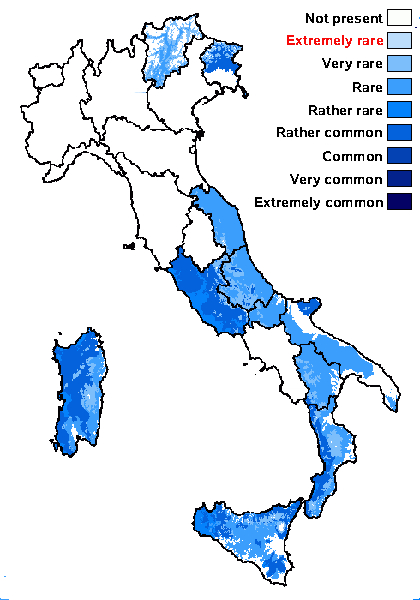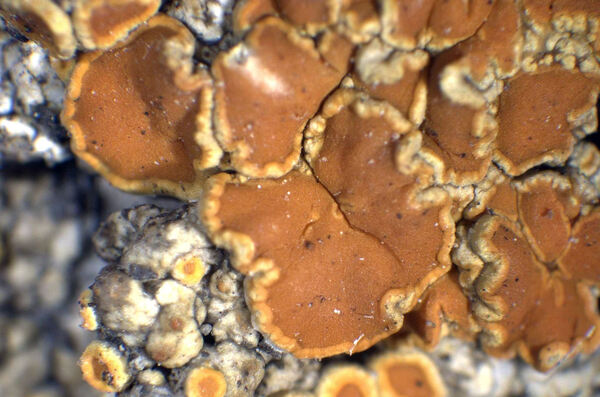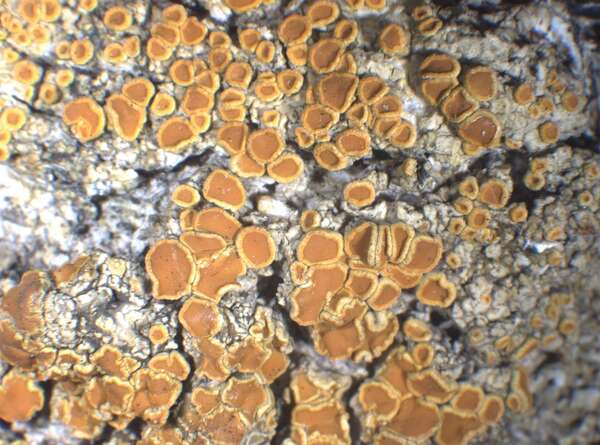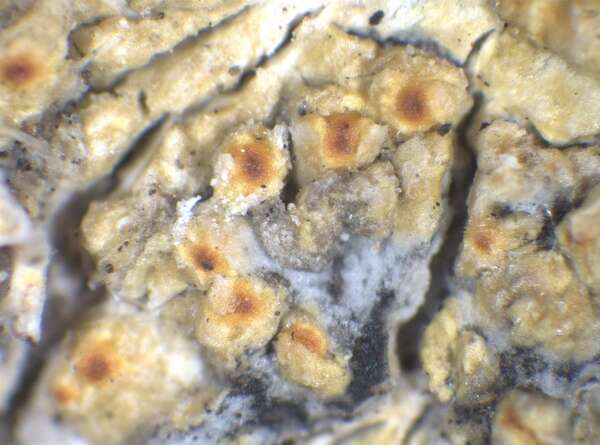Gyalolechia flavorubescens (Huds.) Søchting, Frödén & Arup var. quercina (Flagey) Nimis
The Lichens of Italy. A second annotated Catalogue: 19, 2016. Basionym: Caloplaca quercina Flagey - Rev. Mycol., 13: 114, 1891.
Synonyms: Caloplaca flavorubescens var. quercina (Flagey) Giralt, Nimis & Poelt
Distribution: N - VG (TSB 1608), Frl (TSB 1563), TAA (B 60 0191804). C - Marc (Nimis & Tretiach 1999), Laz (TSB 32402), Abr (Nimis & Tretiach 1999, Gheza & al. 2021), Mol (Nimis & Tretiach 1999, Caporale & al. 2008), Sar (TSB 8512). S - Pugl (Nimis & Tretiach 1999), Bas (Nimis & Tretiach 1999), Cal (Puntillo 1996), Si (Brackel 2008b, 2008c).
Description: Thallus crustose, more or less continuous, sometimes coarsely papillate, yellow-green to yellow-orange in sun-forms, rarely almost grey in shade-forms. Apothecia common, lecanorine, constricted at base, 0.5-3 mm across, with an orange, usually flat disc, an orange to yellow, prominent, raised proper margin, and a well developed, often flexuose or crenulate thalline margin. Epithecium brownish orange, K+ red, C+ purple (in section); hymenium colourless, 50-110 μm high; paraphyses c.1.5 µm thick at base, slightly moniliform, with enlarged, up to 4 µm wide apical cells; hypothecium colourless, sometimes inspersed with oil droplets. Asci 8-spored, clavate, functionally unitunicate, apically thickened with a broad internal beak, the inner part of apex and external cap I+ blue, Teloschistes-type. Ascospores 2-celled, polarilocular, hyaline, ellipsoid 12-19 x 6-11 μm, the equatorial thickening (“septum”) 3-8 μm, to half of spore length. Pycnidia rather common, darker orange than thallus, immersed to slightly projecting. Conidia hyaline, bacilliform to slightly pyriform, c. 2 x 0.7 μm. Photobiont chlorococcoid. Spot tests: thallus K+ red, C-, KC-, P-; apothecia K+ red, C+ purple (the latter reaction not always evident). Chemistry: fragilin dominant, with smaller amounts of emodin and parietin; apothecial disc with chlorinated anthraquinones.Note: a critical taxon, which deserves further study.
Growth form: Crustose
Substrata: bark
Photobiont: green algae other than Trentepohlia
Reproductive strategy: mainly sexual
Poorly known taxon in need of further study
Commonnes-rarity: (info)
Alpine belt: absent
Subalpine belt: absent
Oromediterranean belt: absent
Montane belt: very rare
Submediterranean belt: rare
Padanian area: absent
Humid submediterranean belt: rather common
Humid mediterranean belt: rather rare
Dry mediterranean belt: absent

Predictive model
Herbarium samples
Growth form: Crustose
Substrata: bark
Photobiont: green algae other than Trentepohlia
Reproductive strategy: mainly sexual
Poorly known taxon in need of further study
Commonnes-rarity: (info)
Alpine belt: absent
Subalpine belt: absent
Oromediterranean belt: absent
Montane belt: very rare
Submediterranean belt: rare
Padanian area: absent
Humid submediterranean belt: rather common
Humid mediterranean belt: rather rare
Dry mediterranean belt: absent

Predictive model
| Herbarium samples |





